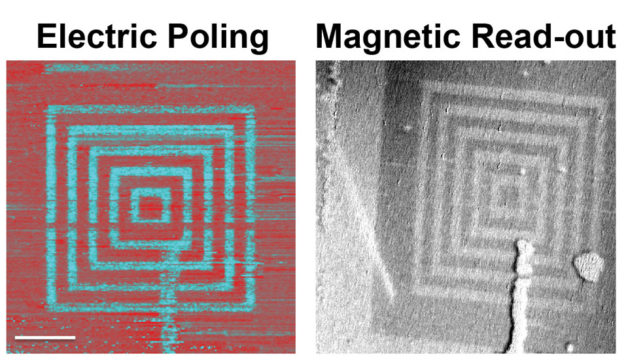Materials that exhibit coupled ferroelectric and magnetic ordering are attractive candidates for use in future memory devices, but such materials are rare and typically exhibit their desirable properties only at low temperatures. Recently, scientists working at the ALS successfully paired ferroelectric and ferrimagnetic materials so that their alignment can be controlled with a small electric field at near room temperature. This achievement is a major step in the development of ultralow-power microprocessors, storage devices, and next-generation electronics.

Researchers from Berkeley Lab and Cornell University engineered thin, atomically precise films of hexagonal lutetium iron oxide (LuFeO3), a material known to be a robust ferroelectric, but not strongly magnetic. Lutetium iron oxide consists of alternating single monolayers of lutetium oxide and single monolayers of iron oxide. It differs from LuFe2O4, a strong ferrimagnetic oxide that consists of alternating monolayers of lutetium oxide with double monolayers of iron oxide.
The researchers found that by carefully adding one extra monolayer of iron oxide to every 10 atomic repeats of the single-single monolayer pattern, they could dramatically change the material’s properties and produce a strongly ferrimagnetic layer near room temperature. This extra monolayer of iron oxide makes one LuFe2O4 formula unit for every nine LuFeO3 formula units. They then tested the new material to show that the ferrimagnetic atoms followed the alignment of their ferroelectric neighbors when switched by an electric field. The experiments were conducted at temperatures up to 700 kelvins (800 degrees Fahrenheit), which is much higher than other such multiferroics that typically work at much lower temperatures.
Ferromagnets and ferrimagnets have similar features, responding to magnetic fields, and are used in hard drives and sensors. Pairing ferroelectric and ferrimagnetic materials into one multiferroic film would capture the advantages of both systems, enabling a wider range of memory applications with minimal power requirements. It is challenging, though, because the forces needed to align one type of material fail to work for the other. Polarizing the ferroelectric material would have no effect on the ferrimagnetic one.
The ultra-precise technique that the researchers used to create this layered stack of oxides allowed them to design and assemble the two different materials atom by atom, layer after layer. They intentionally seated a lutetium iron oxide with alternating iron oxide double layers (LuFe2O4) next to lutetium iron oxide with alternating iron oxide single layers (LuFeO3), and that positioning made all the difference in nudging the ferrimagnetic atoms to move in conjunction with the ferroelectric ones.
To show that this coupling was working at the atomic level, the researchers tested the multiferroic film at ALS Beamlines 11.0.1.1 and 4.0.2. Using a 5-volt probe from an atomic force microscope to switch the polarization of the ferroelectric material up and down, researchers created a geometric pattern of concentric squares. They then showed using photoemission electron microscopy (PEEM) that the ferrimagnetic regions within the layered sample displayed the same pattern, even though no magnetic field was used. The direction was controlled by the electric field generated by the probe. To confirm that the ferroelectric order persists significantly above ambient temperature, the researchers used polarization to demonstrate order up to ~700K.
The unique capability of soft x-rays provided by the ALS to probe magnetism as well as ferroelectricity was crucial to determining the novel characteristics of the engineered multiferroic. The researchers now plan to explore strategies for lowering the voltage threshold for influencing the direction of polarization. They also plan to utilize their understanding of the inner workings of this new material to realize even higher-temperature manifestations.

Contact: Darrell Schlom
Research conducted by: J.A. Mundy, C.M. Brooks, M.E. Holtz, H. Das, A.F. Rébola, R. Held, R. Hovden, E. Padgett, Q. Mao, H. Paik, L.F. Kourkoutis, C.J. Fennie, D.A. Muller, and D.G. Schlom (Cornell University); J.A. Moyer and P. Schiffer (University of Illinois); J.T. Heron (University of Michigan); J.D. Clarkson, Z. Liu, and R. Ramesh (UC Berkeley); S.M. Disseler, J.A. Borchers, and W.D. Ratcliff (NIST); A. Farhan, E. Arenholz, and A. Scholl (ALS); R. Misra (Pennsylvania State University).
Research funding: U.S. Department of Energy, Office of Basic Energy Sciences (DOE BES). Operation of the ALS is supported by the DOE BES.
Publication about this research: J.A. Mundy, C.M. Brooks, M.E. Holtz, J.A. Moyer, H. Das, A.F. Rébola, J.T. Heron, J.D. Clarkson, S.M. Disseler, Z. Liu, A. Farhan, R. Held, R. Hovden, E. Padgett, Q. Mao, H. Paik, R. Misra, L.F. Kourkoutis, E. Arenholz, A. Scholl, J.A. Borchers, W.D. Ratcliff, R. Ramesh, C.J. Fennie, P. Schiffer, D.A. Muller, and D.G. Schlom, “Atomically engineered ferroic layers yield a room-temperature magnetoelectric multiferroic,” Nature 537, 523 (2016). doi:10.1038/nature19343
ALS SCIENCE HIGHLIGHT #343